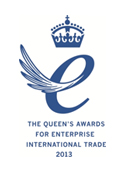GEOMETRY INFORMATION
PART 1 – BASIC WHEEL ALIGNMENT TERMS;
There are three main wheel alignment angles, which determine how each wheel is positioned relative to the car, the ground and each other. These are camber, caster and toe. Camber and Toe angles refer directly to the wheel, while Caster on the other hand is a measurement of the suspension geometry.
We all know what Camber is, right?
Camber is the inclination of the wheel from the vertical relative to the ground when viewing from the front (or rear) of the car.
a) Positive (+ve) camber is when the top of the wheel is laying outwards.
b) Negative (-ve) camber is when the top of the wheel is laying inwards.
Typical camber settings for most road cars are between 0 and -1.0 degree.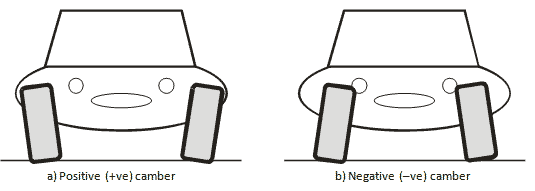
In general, an easy way to increase cornering performance along with matching suspension and tyre upgrades, is to dial in some extra negative camber. For most performance road cars, a suitable camber setting is in the range of –1.0 and –2.0 degrees. One advantage of this is that as the centrifugal force during hard cornering causes the body of the car to roll outwards, the outside tyres which take the brunt of the cornering force, will sit more upright relative to the ground maximising the tread to road contact and ultimately resulting in more grip. However, dialing in too much negative camber can have adverse effect not only on the more obvious tyre wear, but also on performance as well as safety, stability and driving pleasure. Therefore, as with any vehicle modifications, even the simplest suspension geometry alterations should be done carefully, and best left to the professionals.
I’ve heard of caster before, but why is it important?
Caster is the backward or forward inclination of the steering axis when viewing from the side of the car. More precisely, it is an angle between upper and lower steering axis pivot points when viewing from the side of the car. In the case of a McPherson strut suspension layout, the respective points are strut mount for the upper pivot and ball joint in the lower control arm as the lower pivot.
- Positive (+ve) caster is when the upper pivot is behind of the lower pivot.
- Negative (-ve) caster is when the upper pivot is in front of the lower pivot.

The importance of a higher positive caster is quite impressive as the benefits greatly outweigh any detrimental effects. The benefits of increased caster are;
- Increased dynamic negative camber in turns
- Improved high speed stability
- Improved road feel, steering feedback and sensitivity
- Increased steering weight, this can be used to overcome some over compensating power steering systems
- Improves steering turn-in response during corner entry
Is toe referring to tracking?
Toe is in angular position of the wheel when viewing from the top expressed in degrees, or more commonly known as the difference in distance between the front and rear of the tyres expressed in inches or millimetres. Toe is also referred to as tracking, and is known as either;
- Neutral Toe, where the distance between the front and rear of two opposing wheels is equal, or in other words both wheels are pointing straight ahead.
- Toe-in, where the distance between two opposing wheels is greater at the rear of the two wheels, in other words the front of the wheels are closer together then the rear.
- Toe-out, where the distance between two opposing wheels is greater at the front of the two wheels, in other words the front or the wheels are further apart then the rear.
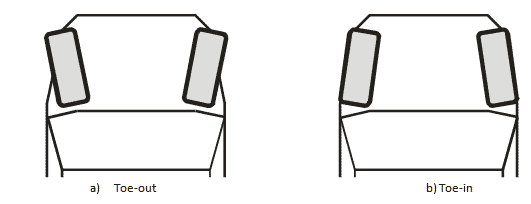
Typically, on most road cars toe is set to between neutral and some toe-in. Generally, toe-in improves stability and reduces nervousness, while neutral to toe-out improves turn-in and sharpness.
PART 2 – BASIC SUSPENSION GEOMETRY TERMS;
Steering Axis Inclination (SAI) (also known as King Pin Inclination or KPI) is similar to caster above, as it is an angular measure of the upper and lower steering axis pivot points, but unlike caster which is measured from the side, SAI is measured from the front of the car.
Thrust Angle is the difference of rear wheels’ individual toe angles. If individual toe angle of each rear wheel is not equal, then the rear wheels will try to turn the car from the back, not unlike a rudder on a boat. This is known as thrust angle.
‘Anti- ‘Geometry;
There are a number of ‘anti’ geometry features, with the main three known as;
- Anti-lift – refers to the amount of built-in anti-lift built into the front suspension of front/all-wheel-drive cars (relies on drive torque). The more anti-lift there is, the less the front will lift during acceleration, at a cost to traction and comfort. Generally, reducing the amount of Anti-lift geometry improves traction across the front axle, and therefore reduces understeer so often found on most road cars.
- Anti-dive – refers to the amount of built-in anti-dive in the front suspension of any car (relies on braking torque). The more anti-dive, the less the front of the car will compress during braking, at a cost to comfort and increased chance of brake lock-up.
- Anti-squat – refers to the amount of anti-squat built into the rear suspension of rear-wheel-drive cars (relies on drive torque). The more anti-squat, the less the rear of the car will compress during acceleration, at a cost to comfort and increased chance of loss of traction at lower speeds.
In simple terms, increasing anti- geometry has a similar effect of increasing suspension stiffness. Some is good, but too much can be detrimental. Therefore the exact amount must be carefully designed by suspension engineers.
Toe (Bump) Steer;
Toe Steer is where during vertical suspension movement, the suspension geometry is designed in such a way that results in some change to the toe-angle. While a minor amount of toe steer can be acceptable, it is generally best to have as little toe steer or none at all.
PART 3 – BASIC VEHICLE DYNAMICS TERMS;
There are many factors that determine the dynamic behaviour (handling) of a car, such as front to rear weight distribution, tyre grip, suspension and geometry design, specifications and settings to name just a few. It is quite a complex mix, but the end result determines the basic handling characteristics; these being understeer, neutral and oversteer.
Understeer is a term used to describe when the car travelling along a curve actually travels at a greater curve (or a straight line) to that of the intended path. In other words, instead of going around a corner, the car pushes wide and does not want to turn. Some understeer is arguably desirable, as it is a safe state, easier to control and recover from. This is the reason why most production road cars are designed with some level of understeer.
Oversteer is simply the opposite to understeer, where the rear of the car steers more than the front resulting in the vehicle going into a spin. This can be difficult to control and contain by an average driver, and therefore can be classed as the more dangerous of the two extremes.
The ultimate vehicle dynamic however is neutral balance, although being the most challenging to achieve.
PART 4 – SUSPENSION TUNING;
So, what does all this mean?
Wheel alignment and geometry settings are fundamental to vehicle road holding, cornering performance, driving pleasure and safety. Getting the ‘right’ wheel alignment and geometry recipe is critical, but must be done in a way that it complements the mechanical suspension specifications and vehicle usage. Taken that extra step further, the right formula should also match the driving style.
As the ‘optimum’ recipe depends on so many varied factors, it is quite difficult to know what it actually should be. But, it is true to say that, on cars with un-modified suspension and rolling stock, it is best to follow manufacturer’s recommended settings as listed in the owners’ or workshop manual. This is also a good guide to start from for improving the handling performance of your car, whether it is simply to improve the road holding, straight line stability and feel during high speed motorway driving, or if absolute cornering grip is your thing. We believe that there is always room for improvement, whatever car you have or however and wherever you drive it.
Now, while on most cars, toe is adjustable – at least on the front axle – camber and caster on the other hand are often not adjustable. So, if all geometry and wheel alignment settings are correct, only requiring some minor toe adjustment, then that’s fine. However, more often than not, this is not the case. Although modern cars are made to much tighter tolerances than ever before, they are still made to a cost (read compromise) where some adjustment to either camber or caster or both is required to get them to their optimum position. On a car with no provision for factory adjustment this becomes a problem.
Fortunately, this is where Powerflex comes into place, offering smart solutions for your suspension’s short comings with a range of Powerflex Geometry Adjustable Products. Whether you are looking to fix your day-to-day vehicle, increase the handling potential of your hot hatch or set up your sports car for some weekend racing, chances are you will need the Powerflex Geometry Adjustable Components GAC.
Please note; the above is intended to be used as a general guide on basic suspension terms and conditions, with the aim to stimulate further thought and research. If you have any comments, requests or suggestions, please feel free to contact us. We welcome and respect all feedback.



- Design for track
- Ready to Race
- Engineered to the best


Contact Us for all your bush suspension solutions
We are very proud to be a certified ISO9001 company and receiver of the Queens’s Award for Enterprise and international trade 2013
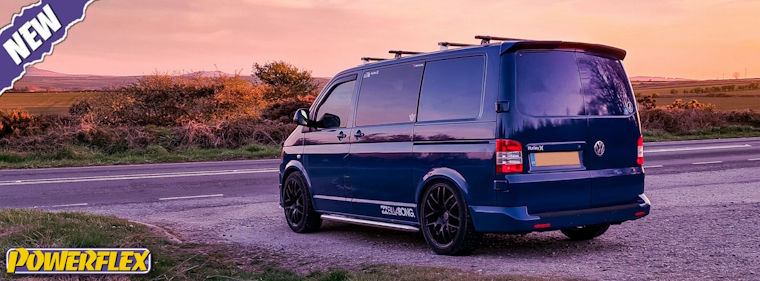
17th January 2025
NL2025-03 VW Transporter T5 & T6 Handling PacksThis week, we are launching two new handling packs, which provide everything you need to enhance your T5/T6.
Read more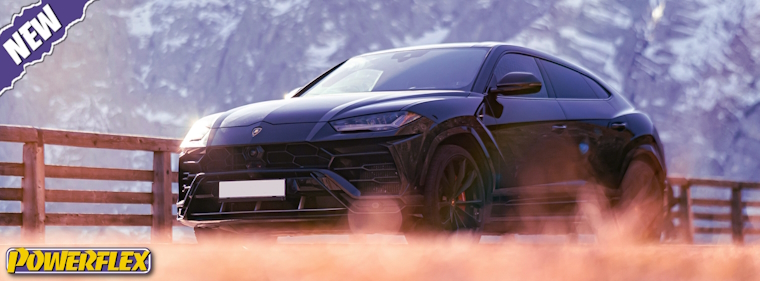
7th January 2025
NL2025-02 VAG SUV MLB Evo platform Jack PadThis week we are pleased to announce a new addition to our Porsche Jack Pad Range
Read more




